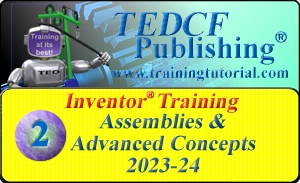Autodesk Inventor 2023-24 Training Course 2
The Inventor 2023-24: Assemblies and Advanced Concept course continues your journey of learning sound practices and procedures. So you should successfully pass the Solid Modeling exam before attempting to take this course.
It shows you practical ways of applying Top Down, Middle Out, and Bottom Up assembly modeling. It even shows you how Kinematics can be used to develop complicated mechanisms. You'll also learn advanced methods of creating part models.
You'll learn how to use Model States as well as an alternate method of keeping track of progressive models. As with all our courses, this course gives you the tools to accomplish your goals. So you can chose to use Model States or the alternate method.
iFeatures, iParts, and iAssemblies are covered in detail while keeping your focus on productive methods of using these tools. In fact the advanced methods of creating iFeatures taught in the course will significantly improve the quality and speed of your work. For example, tapered pipe threads are somewhat complicated, and creating them from scratch can take a great deal of time. With their complexity most users cannot create iFeatures that make them. You won't have any problems. With a click of a button you'll make fully cut tapered pipe threads. Using the same procedure you can make iFeatures for your complicated features.
Making assemblies function like real assemblies also requires a professional skill set. You'll understand every facet of Adaptive Assemblies, Flexible Assemblies, Contact Set, Collision Detection, and so much more. You'll be able to demonstrate the range of motion of assembly components, animate the motion, and you'll know how to record the animation.
Advanced methods of creating single parts are also covered in the course. You'll learn how to derive components from other components, create scaled versions, and you can create mirrored copies.
There are too many topics covered in detail to describe here. Read through the list of lessons. Each lesson covers the topic in detail and is packed with tips and tricks that improve the quality of your work and speed your throughput.
The Autodesk Inventor 2023-24: Assemblies and Advanced Concepts course is a must see.
115 Lessons (Listed Below)
10.7 hours of instruction
You can also browse through the lessons from the following Inventor 2023-24 courses and watch sample lessons.
Inventor 2023-24: Solid Modeling Inventor 2023-24: Assemblies and Advanced Concepts Inventor 2023-24: 2D Drafting and Customization Inventor 2023-24: Sheet Metal DesignOur Inventor courses require No Installation. You can watch them on any device connected to the internet.
You will receive an email containing your User Name and Password. Login to your account and start learning. It's that easy.
While you're logged into your account you can download files used in the courses, watch lessons, practice the tasks taught in the lessons, and take the final exam. Keep in mind that you will use your installation of Inventor to practice.
Get your Inventor 2023-24 training now. You can start learning in minutes.
Autodesk Inventor® 2023-24:
Assemblies and Advanced Concepts
No Installation Required
Watch from any device connected to the internet.

$54.95 - $109.95
Watch Sample Lessons
Watch the first hour of the Solid Modeling course for Autodesk Inventor 2023-24.
 Click to Watch!
Click to Watch!Assemblies and Advanced Concept
10.7 hours of instruction
Lessons
Introduction
Sketch Origin Node
Using and Creating Templates
Creating Derived Parts
Editing Derived Parts
Intro to the Assy Environment
Degrees of Freedom
Driving Constraints
Explicit Reference Vectors
Adaptive Parts and Sketches
Adaptive Constraint Strategies
Creating Adaptive Parts I
Creating Adaptive Parts II
Using Constraint Strategies
Removing Adaptivity
Driving Adaptive Assemblies
The Content Center
The Symmetry Constraint
Ball Joints
Planar Joints
Joint Alignment Details
Cylindrical Joints
Slider Joints
Rotational Joints
Rigid and Automatic Joints
Mirrored Assemblies
Mirrored and Copied Constraints
Flexible Assemblies
Copied Assemblies
Pattern Components
Advanced Viewing
Assembly Viewing
Motion Constraints
Animating Gears Motion
Animating Gears Contact Set
Transitional Constraints
Collision Detection
Contact Solver
Checking for Interferences
Creating Compressible Springs
Driving Adaptive Springs
Positional Representations
Creating Presentations
Editing Tweaks
Working with Storyboards
Presentation Opacity
Presentation Camera Settings
Animating Presentations
Presentation Snapshot Views
No Storyboard Exploded Views
iFeature Design
Inserting iFeatures
Reusing Part Features
Advanced iFeature Design
Reducing Dangling Geometry
Creating iPart Factories
iPart Members
Editing the iPart Author
iMates and iParts
Custom iParts
Creating iPart Assemblies
Updating iParts
Threaded iParts
iMates and the Content Center
Identifying and Using iMate Glyphs
Inferred iMates
Scaling Parts
Combining Parts I
Combining Parts II
Subtracting and Splitting Parts I
Subtracting and Splitting Parts II
Deleting Faces
Strategy for Splitting Parts
Trick for Measuring Interferences
Prep for Design Accelerator
Bolted Connections
Generating Bearings
Generating Shafts Part I
Generating Shafts Part II
Generating Shafts Part III
Generating Gears
Generating Keyways
Preparing for Model States
Defining Model States
Advanced Arrays
Working with Model States
Fixing Model States
Model State iProperties
Assembly Model States
Saving Under Part Number
Saving Under Assembly Number
Working with Large Assemblies
Adaptive vs Positional Rep
Using Design Views
Introduction to Simplify
Simplify Properties Settings
Presets Envelops and Includes
Modifying and Deleting Presets
Skeletal Modeling Introduction
Make Part and Components
Kinematics
Sketch Blocks
Advanced Top Down Design
Blocks and Assemblies
Modeling Techniques I
Modeling Techniques II
Portable Content Center Files
Modifying Block Assemblies
Hybrid Design Methods
Alternate Slice Method
Import Assy to Part File
Middle Out Design
Exporting Bodies to an Assembly
Replacing Assemblies
Conclusion
